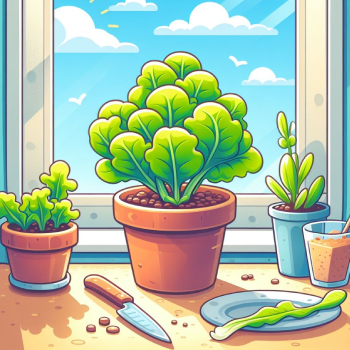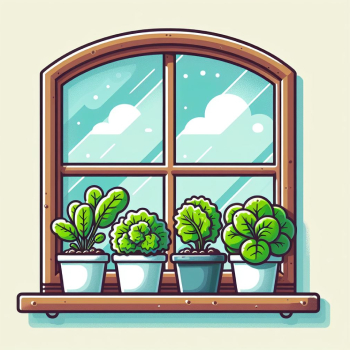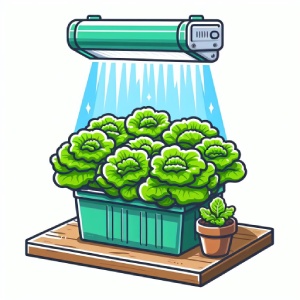
Growing lettuce indoors: Light, space, the best varieties, and the worst pests
Growing lettuce indoors isn't just about having a steady supply of fresh greens; it's about adapting to the urban lifestyle by bringing the garden indoors.
After all, urban gardening is trending, proving that you don't need acres of land to enjoy the satisfaction of growing your own veggies - and indoor lettuce is one of the cheapest and easiest ways to dip your toes into the water.
Advice from the experts 👩🌾
Surround your indoor lettuce garden with aromatic herbs like mint or basil. Not only will it create a pleasant atmosphere, but some herbs also act as natural pest repellents.
Indoor lettuce varieties
Growing lettuce indoors isn't like doing so in the garden. Light, temperature, and space conditions and requirements are all different - so you need to make sure you pick your lettuce variety carefully.
Luckily, there are a lot of varieties of lettuce suitable for indoor growing, although their specific needs (and taste!) does vary. Here’s a simple breakdown.
| Indoor lettuce variety | Taste | Light requirement | Space requirement |
|---|---|---|---|
| Tom Thumb | Flavorful | Moderate to bright light (6-8 hours per day) | Small containers or tight spaces (6-8 inches deep) |
| Little Gem | Intense taste | Moderate to bright light (6-8 hours per day) | Suitable for compact spaces (6-8 inches deep) |
| Red Russian | Nutrient-rich | Moderate to bright light (6-8 hours per day) | Versatile, fits in various spaces (6-12 inches deep) |
| Forellenschluss | Vibrant and nutritious | Moderate to bright light (6-8 hours per day) | Adaptable to small containers (6-8 inches deep) |
| Buttercrunch | Mild and sweet | Moderate to bright light (6-8 hours per day) | Ideal for larger indoor spaces (8-12 inches deep) |
Urban Gardening Hub recommends: Buttercrunch. What sets Buttercrunch apart is its versatility. This lettuce variety is not just a team player, it's the MVP. It's ideal for larger pots or containers, making it perfect for those who want to cultivate a bit more greenery in their indoor haven. Buttercrunch doesn't just stop at taste – it's forgiving. So, if you're still mastering the art of indoor gardening, fear not. This lettuce variety is resilient and thrives in moderate to bright light conditions. Whether you're a seasoned gardener or a budding enthusiast, Buttercrunch lettuce is the dependable, mild-mannered superhero your indoor garden needs."
Best containers for growing lettuce indoors
Container size: Choose containers that are at least 6-8 inches deep (here's some we found earlier!) to allow for proper root growth. The width of the container will depend on the variety of lettuce you're growing and the available space, but a container with a diameter of at least 10-12 inches is generally suitable for a single lettuce plant.
Spacing: If you're planting multiple lettuce plants in a single container, make sure to space them adequately to prevent overcrowding. For loose-leaf varieties, space plants about 6-8 inches apart. For heading varieties, which require more space to develop, leave 10-12 inches between plants.
Drainage: Ensure that the containers have adequate drainage holes at the bottom to prevent waterlogging, which can lead to root rot. Proper drainage is crucial for healthy lettuce growth.
Depth: While lettuce roots aren't excessively deep, they still require enough room to spread out. Aim for containers with a depth of at least 6 inches to allow the roots to develop fully and support healthy plant growth.
Room for growth: Keep in mind that lettuce plants will grow rapidly, especially in optimal indoor growing conditions. Choose containers that provide enough room for the plants to reach their full size without becoming cramped.
Consider vertical options: If space is limited, consider vertical gardening solutions such as stackable planters or wall mounted planters. These can maximize space utilization while still providing adequate room for lettuce growth.
Overall, providing sufficient space and appropriately sized containers is essential for successful indoor lettuce cultivation, ensuring that the plants have the room they need to thrive and produce a bountiful harvest.
Optimising light conditions for indoor growing
DIY artificial lights
Invest in LED strip lights, readily available at your local hardware store, and fashion your own personalised lighting system. Suspend the strips above your lettuce pots or wrap them around shelves, providing your greens with a tailor-made sun. It's like creating a mini Broadway for your lettuce, with each LED bulb playing a crucial role in the dazzling spectacle of growth.
Specialist artificial lights
Brands like Aerogarden offer LED grow lights designed specifically for indoor gardening. These lights are engineered to provide the optimal spectrum for plant growth, ensuring your lettuce receives a professional-grade performance of light that rivals the sun itself. Embrace the sophistication of horticultural technology as you watch your lettuce thrive under the guidance of these advanced lighting systems.
Maximising natural light
Harnessing natural light is the time-tested method for cultivating thriving indoor lettuce. Place your pots strategically near windows with indirect sunlight, turning your humble abode into a lettuce haven. Consider using sheer curtains to diffuse intense sunlight and avoid leaf burn. Rotate your pots regularly to guarantee each leafy tenant gets their fair share of the natural spotlight. It's a dance between your lettuce and the sun, choreographed to perfection.

Temperature and humidity control
In the delicate ballet of indoor lettuce cultivation, temperature and humidity perform the leading roles, dictating the rhythm of your green haven. Let's dive into the ideal conditions that transform your indoor space into a sanctuary of optimal growth for your leafy companions.
For temperature, lettuce prefers a Goldilocks zone – not too hot, not too cold. Aim for a temperature range of 15 to 21 degrees Celsius (60 to 70 degrees Fahrenheit) during the day, ensuring a comfortable atmosphere that encourages robust growth. To achieve this, consider using a small fan to circulate air and maintain a consistent temperature. Additionally, if your indoor space tends to get too warm, strategically placing a tray of water near your lettuce pots can act as a natural cooling system.
Humidity plays the supportive background melody, with lettuce thriving in relative humidity levels between 40% and 60%. To maintain this sweet spot, incorporate a humidifier into your indoor garden. Modern humidifiers offer easy control, allowing you to adjust humidity levels with precision. Alternatively, regular misting with a spray bottle can simulate a humid environment. Grouping plants together can also create a microclimate, enhancing humidity levels naturally.
Maintaining this controlled environment isn't just about pampering your lettuce; it's about creating the perfect haven where they can thrive and flourish. So, fellow indoor gardeners, let's orchestrate the ideal symphony of temperature and humidity, turning your space into a lettuce sanctuary.

Hydroponics and innovative methods
Welcome to the avant-garde of lettuce cultivation, where soil takes a back seat, and innovation takes the wheel. In this section, we'll explore the revolutionary world of hydroponics and other creative techniques that redefine the way we nurture our leafy companions indoors.
Hydroponics, the rockstar of indoor gardening, dismisses soil entirely, allowing lettuce to dance with its roots in nutrient-rich water. Imagine a world where traditional gardening constraints disappear, and lettuce receives its nourishment directly. Hydroponic systems, such as nutrient film technique (NFT) or deep water culture (DWC), offer precise control over the growing environment, promoting faster growth and higher yields. It's like a VIP treatment for your lettuce, ensuring it gets the nutrients it needs without any soil-related drama.
Now, let's turn the dial to even more unconventional methods. Enter aquaponics – a dynamic duo of aquaculture and hydroponics. In this symbiotic system, fish waste provides nutrients for lettuce, creating a self-sustaining ecosystem. It's an underwater love story where fish contribute to the flourishing dance of lettuce leaves.
If that's not adventurous enough, consider vertical towers. These futuristic structures elevate your lettuce to new heights, literally. Vertically stacked planters allow you to make the most of your vertical space, ideal for urban dwellers with limited room. It's a lettuce skyscraper, where each level contributes to the green skyline of your indoor garden.

Pest management
Even in the cosy confines of your indoor lettuce haven, pests might sneak in for an uninvited feast. Fear not, for we're about to unravel the secrets of pest management tailored to the indoor lettuce ecosystem. Let's build a shield to protect your leafy companions and ensure they thrive without any unwanted guests.
Indoor lettuce cultivation brings forth its set of unique pest challenges. Keep an eagle eye out for aphids, spider mites, and whiteflies, notorious for infiltrating indoor spaces. These tiny intruders might be stealthy, but with the right measures, they won't stand a chance in your lettuce sanctuary.
When it comes to indoor pest control, nature often holds the best solutions. Introduce natural predators like ladybugs or predatory mites to create a harmonious ecosystem that keeps pest populations in check. Neem oil, derived from the neem tree, acts as a potent deterrent against pests without harming your lettuce. Additionally, a mild soapy water solution can be an effective, environmentally friendly way to manage pests without resorting to harsh chemicals.
Prevention, however, is the best form of defence. Regularly inspect your lettuce for signs of pests, even if they're not visible at first glance. Ensure proper ventilation and air circulation to deter certain pests. Quarantine new plants before introducing them to your indoor garden to prevent potential pest hitchhikers.
Harvesting and continuous yield
As your indoor lettuce garden flourishes, it's time to reap the rewards and ensure a continuous supply of crispy greens for your table. Harvesting lettuce is an art, and mastering it will guarantee a perpetual bounty from your indoor oasis.
When it's time to harvest, opt for a cut-and-come-again approach. Snip outer leaves near the base, allowing the inner leaves to continue growing. This gentle method ensures a continuous yield without uprooting the entire plant. Harvest in the morning for the freshest leaves, and use sharp scissors or shears to minimise damage to the remaining foliage.
Believe it or not, your lettuce has a secret superpower – regrowth. Certain varieties, especially loose-leaf types, can regrow from the cut stems. Instead of tossing the remnants, place them in water or soil, and watch as new leaves sprout. It's a sustainable practice that turns every harvest into a promise of more to come.
As you savour the joy of harvesting, remember that lettuce is the gift that keeps giving. With careful tending and a bit of finesse in your harvesting technique, your indoor lettuce garden will provide a continuous yield, ensuring a fresh supply of homegrown goodness for your culinary adventures.
And there you have it – the keys to unlock the vibrant world of indoor lettuce cultivation. From unconventional lighting to innovative growing methods, and the battle against pests to the joys of continuous harvesting, your indoor garden is now a thriving haven for crisp, homegrown greens. So, fellow gardeners, let your lettuce adventure unfold, and may your harvests be bountiful and your salads ever fresh!

